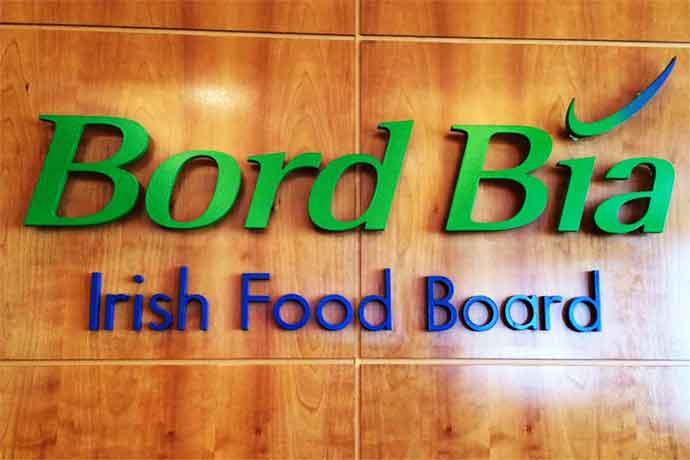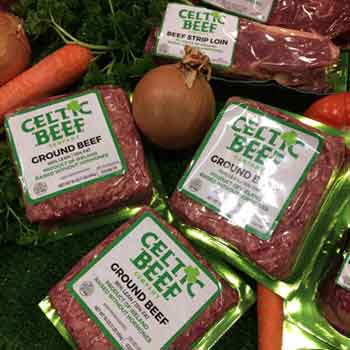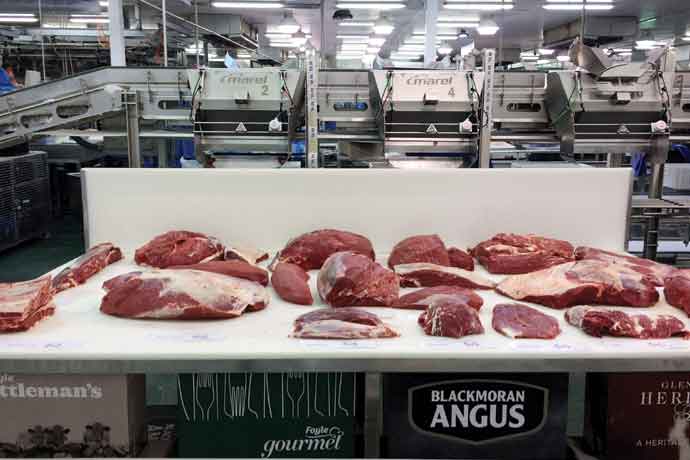Editor’s note: In 2015, Ireland became the first European Union member state to export beef primal cuts to the United States after a 15-year absence. Since then, the Irish Food Board (Bord Bia) has taken on the mission of opening new markets for Irish beef producers.
That mission brought Bord Bia representatives to the 2018 Annual Meat Conference held in Nashville, Tennessee, in March. Tara McCarthy, Bord Bia’s chief executive, Michael Creed, Minister for Agriculture, Food and the Marine and a delegation of Ireland’s leading beef exporters traveled to Nashville to launch a trade campaign highlighting Irish beef quality and sustainability attributes to potential retail partners and buyers.
Following the Meat Conference, Bord Bia invited MEAT+POULTRY and journalists from around the world to visit Ireland to learn more about the country’s grass-fed beef production, national traceability and sustainability programs.
Mark Zieg juggles the dual role of beef producer and director manager, Beef at Bord Bia. He says that overall, Ireland exports approximately 550,000 tonnes of beef, and frequent mixed grazing of cattle and sheep is common.
“Our little island has 51,000 sq. km., 4.6 million people in the south of the island,” Zieg explains. “We have more bovines than people by far in the south – 2 million more.”
Ireland is blessed with frequent rains with a little sunshine in between showers.
“We have the Gulf Stream, coming from the Gulf of Mexico, picking up all of the warm air, picking up moisture coming over the Atlantic, and we’re the first thing it meets and drops a lot of moisture – 800 to 1,200 millimeters of rain,” Zieg says. “That’s why 80 percent versus 40 percent of the farm area is in grass. As you go through continental Europe, you don’t tend to see so much grass – you’ll see more crops, you’ll see some maize grown.”
Keeping it small

Cattle ranching is grass-based. Taken as an average over a year, 95 percent of the feed given to beef cattle is grass. During the winter, which lasts about four months, cattle are kept indoors and fed silage – fermented grass that can be fed to cattle and sheep or used in anaerobic digesters as biofuel feedstock.
“The cattle are brought indoors and fed silage or hay and some grain,” Zieg says. “Cattle that finish between April and August will get no grain because the grass has enough sugars and protein to give the cattle a good fat cover.
“That’s very traditional; that’s the way we’ve always done it. It hasn’t really moved on a lot from there, so we haven’t moved to the feedlotting system as such,” he adds. “The family farm remains in Ireland. The units are smaller (and) there is a degree of specialization that one farmer will do cow-calf and others will do the finishing. It’s not always that way; there’s much more of a mix because it really depends on the varying conditions that we have throughout the country. But even the finishers at the end will tend to utilize their grass in the summer, make silage and feed it in the winter, then add other feeds to supplement that.”
Most of the 4.3 million hectares of grassland, roughly 80 percent, is split evenly among the 6.7 million head herd. The herd is comprised of 1.2 million for the beef industry and 1.4 million head for the dairy industry. Most of the cattle farms average 55 head, and there are very few herds that are more than 500 head and even fewer over 1,000 head.
Steer and heifer beef production is still dominant in Ireland compared to continental Europe where there’s a lot of bull-beef production. “We don’t do that because it drives the animal towards being fed a lot on grains which doesn’t suit our system and our profitability,” Zieg says. “In Ireland, studies here have shown that the profitability from utilizing your grass well in a beef system is much higher than doing it from grains, because grains are relatively more expensive here than it would be elsewhere.”
The mostly grass-based diet of the cattle produces a darker, richer colored meat and yellow fat. “You’re getting higher concentrations of the three polyunsaturated fats, reduced saturated fatty acids as a correlation of that,” Zieg says. “Also, higher vitamin E. Our customers are finding that it’s a more stable product with a longer shelf life.”
“We’re a European exporter; we have focused very much on high quality and getting into the blue-chip retailers and foodservice accounts and aligning with them and our customers like Kepak, Foyle, ABP and Dawn – they would be very closely aligned with these suppliers and those retailers,” Zieg says. “As a result, we’re on more of the shelves of more EU retailers than that of any other country. Obviously, in most of those other countries they have their own domestic supply, but we would be the main top-up supplier. Indeed, in the UK, our neighbor, Irish beef is the only listed top-up supply.”
Thirty-two abattoirs are approved for export with ABP, which merged with Slaney Foods; Dawn Meats and Liffey Meats as the leading exporters accounting for 75 percent.
Predominant breeds produced in Ireland are Angus and Hereford, followed by some short-horn cattle. Zieg says there are more dairy cattle in Ireland that are often crossed with easy-calving breeds with higher value. Heavy “continental” breeds such as Charolais and Limousin are declining, he adds.
McDonald’s Corp. accounts for about 10 percent of total Irish beef production, Zieg says. “They have very specific requirements in terms of quality assurance and sustainability, which we are very enthusiastic in participating.
“The fact that we have this system where we’re going into farms every year, and we’re assessing the information and taking it up, we thought was the best way of making a really reliable system of proving the claims,” Zieg says. “It’s been very useful to us, and it’s something we’re going to use in the future because we feel that one of the things going forward is that people want to know the claims you’re making really stand up – that there’s visibility and you can prove what you’re doing.”
Because of Ireland’s commitment to sustainability and full traceability, farmers are required to record every dose of medicine administered to an animal, and residue analyses are done as confirmation. As part of Ireland’s AIM system, a calf must be tagged within seven days and must be registered within 27 days and it gets a passport. “That goes right through with it, even if it changes hands it’s all computerized, and as soon as it goes through a cattle market that computer record is changed,” Zieg explains. “If the passport details don’t stack up, that animal won’t be let into the factory.” The information is passed on to each cut taken from each animal.
“If any residues are found, that farmer cannot slaughter any animals,” he says. “He’ll have to clear out his whole herd. It’s law that you have to keep a record of any of those sorts of treatments.”
Zieg acknowledges consumer demand for antibiotic-free meat, however within the Irish beef industry there is no push to segregate cattle given antibiotics to treat illness from cattle that are never given antibiotics. “It is something that we’d have to look at,” he says. “Are you doing yourself a favor? Is it morally right to be doing that? Somebody’s getting that batch of animals that got all the antibiotics. In any case, we’re saying the usage is controlled. When the farm audit happens, that’s probably the most stringently controlled input.”
Kepack connection
Another stop during the Irish beef tour included a tour of the Kepak Meat Division in Clonee, County Meath. Kepak employs 5,000 people and operates in more than 43 countries globally. The company processes beef, lamb and pork and runs 16 manufacturing sites between Ireland and the United Kingdom. Kepak recorded revenues of $1 billion in 2017.
In the company’s beef business are eight slaughter halls and six boning halls for processing 500,000 head of beef per year. Victoria Antoniades, marketing and brand strategist at Kepak, notes that 27 percent of cattle come from their birth farms. She says zero to one movement is very valuable to Kepak customers and to their story to the consumer.
“We also do value-added processing, and we do multi-pack for our packaging format where we work very, very closely with our customers, and everything is produced to their specifications,” she says. “We tailor everything for them.”
Kepak has specific brands around the Angus and Hereford breeds of cattle. The largest amount of cattle produced in Ireland are continental breeds  such as Charolais, Limousins and Simmenthals. Slaughter-ready, or dead weight is roughly 340 kg. on average. “Your Angus and your Hereford would typically be a little bit lighter, maybe closer to the 300- to 310-mark carcass weight,” says Aoife Ryan, head of Project Management Office. “Other breeds, such as Belgian Blues, would be a good deal heavier.”
such as Charolais, Limousins and Simmenthals. Slaughter-ready, or dead weight is roughly 340 kg. on average. “Your Angus and your Hereford would typically be a little bit lighter, maybe closer to the 300- to 310-mark carcass weight,” says Aoife Ryan, head of Project Management Office. “Other breeds, such as Belgian Blues, would be a good deal heavier.”
Celtic Beef is Kepak’s retail brand in the US, and the company is the only Irish beef producer to have a retail brand in the US. It is sold through Wellesley, Massachusetts-based Roche Bros. “They’re predominantly in affluent areas that have an Irish link to it in heritage.”
Antoniades says Kepak’s game plan is to stay within areas that have Irish links because it’s more than enough volume for the company by doing that. “Going out further than that,” she explains, “it’s just another story that has to be told from the start.”
Kepak began sales of Celtic Beef three years ago, mainly focusing on retail. Since then, Kepak has added strip, ribeye, filet and just this year, corned beef which sold out. Antoniades says pitching Irish beef to American consumers has been a positive challenge for Kepak. She says, “…in Europe, I feel like the story of Irish beef is known; we’re known for having a natural and high-quality product that for a very long time we haven’t had to go out and sell that. That’s your baseline – people understand it.”
“When we were [in Nashville] they needed no convincing; everyone loves their meat, but everyone loves American meat,” she adds. “That made us really home in and think ‘why is our beef as good as we say it is,’ especially if you have no-antibiotics-ever and organic and all these offerings. It really did make us think about what we’re asking.”
Foyle First

About a three-hour drive from Kepak is County Donegal where Paul Armstrong works as group commercial director for Foyle Food Group.
Foyle Food Group and ABP Food Group were the first Irish meat processors to receive US Dept. of Agriculture approval to export beef to the US. “We were either lucky or unlucky,” Armstrong says. “But it was good because we were successful.” The company has been exporting beef to the US and Canada for the past four to five years.
Foyle is structured in three key divisions — slaughter/debone; further processing which is the retail packing plant and Eco, which is the rendering business.
Foyle operates six sites and nine business units across Ireland and the United Kingdom. The company employs 1,150 workers. Foyle is a single-species processor slaughtering 7,000 head of cattle per week. Five percent are killed in the Republic of Ireland and 10 percent are killed in the UK. The company slaughters approximately 700 Aberdeen Angus per week in addition to some Hereford. Foyle also operates an organic-approved plant in Gloucester. Estimated income in 2018 is 400 million sterling ($513 million), Armstrong says.
Seventy percent of Foyle’s beef production is destined for the UK and Ireland while 30 percent is exported to customers in the US, Canada and the Philippines among other countries. Retail and foodservice customers of Foyle include Tesco, Costco Wholesale, Radisson Blue Group, McDonald’s, Burger King, Ahold Delhaize and the Wetherspoon pub chain.
As of this year, Foyle is selling frozen patties, chilled burgers, skin-pack steaks, primals and offal. Bulk minced meats are a mainstay of production as the popularity of ready-to-eat meals grows among younger consumers. A significant capital investment for the company was the installation of four Sensor X machines. “It uses a system of x-ray technology to take the meat used for grinding to ensure there’s no contamination, number one, and number two that we’ve got the correct CL (chemical lean) levels for grinding,” Armstrong explains.
“We have four out of five machines that exist in the whole of Ireland and the UK,” he adds, “so that’s roughly about a million euros a site. It gives you loads of benefits from the accuracy of the CL point of view but also from contamination point of view and integrity of product.”
Foyle also is one of the few meat processors to conduct DNA testing of each carcass.
A worker takes a swab sample as the carcass comes down the line, and the information is added to the data supplied by the AIM system – the age of the animal, sex, breed and the producer.
DNA samples — on the same day of kill — are immediately sent to IdentiGen, a leading provider of DNA identification solutions with laboratories in Ireland, UK, US and Canada. IdentiGen processes and stores the samples. Foyle’s customers with access to the IdentiGen system can, independently and without the company’s knowledge, ask for traceability on a sirloin or a mince. “It’s really gold-plated traceability,” Armstrong says.
“We DNA sample every animal,” he adds, “so, we can take a steak and we can tell you the animal it came from and the whole history of that animal. We’re one of the few that are doing it. Not everyone is doing it; we do it for absolutely every animal. We’ve more information probably on our animals in Ireland than we do our people.”

